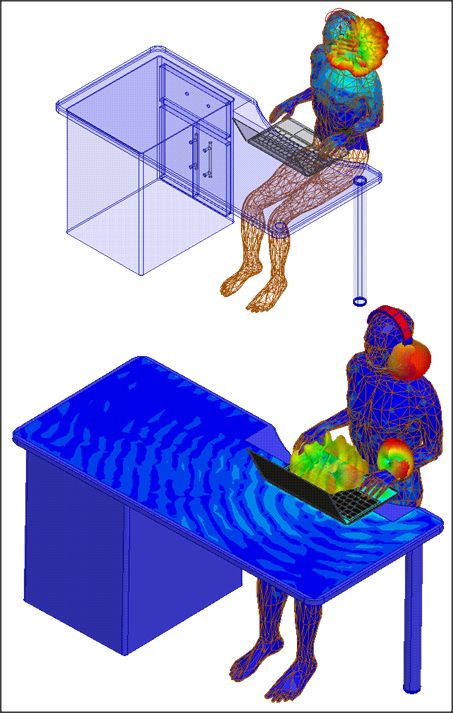The in vivo, in vitro and in silico revolution
The first revolution in modern medicine began over 500 years ago through the work of Leonardo Da Vinci and his contemporaries at the time. They focused on the dissection of human bodies to determine how they worked. This led to the first rudimentary forms of testing in vivo. In the 19th century, a second revolution occurred with scientists such as Pierre and Marie Curie, they developed tests giving quick results without risk for the patient: in vitro testing became popular.
We are currently on the brink of the third revolution in medicine, namely the in silico revolution. This refers to the use of a computer as the test environment, the technique is referred to as engineering simulation.”
Through the use of fundamental equations, we can predict how a virtual prototype will behave, before manufacturing it.

interaction of implantable and wearable devices with the body
Engineering simulation predicts the behavior of any given product, for example a medical device such as an implant or prosthesis. Marchal explains: “Through the use of fundamental equations, such as mass conservation, energy conservation or Newton’s laws, we can predict how a virtual prototype will behave, before manufacturing it.” In silico testing is done in preparation of preclinical and clinical trials; it allows accurate determination of the best parameters for the design of the product. This guarantees a higher success rate of the preclinical and clinical trials and can dramatically increase the pace of innovation, while decreasing the costs. “In silico testing is very reliable, because you can perform many tests at the same time, very early in the development process. It provides extremely valuable information in a relatively cheap way,” says Marchal.
Modeling a human
Simulating a car or an airplane seems easy, but how can you simulate a human? According to Marchal, it is not such a difficult task: “Of course, a human is more complicated than a car in terms of geometry, but that’s why we start from a typical MRI or CT scan. The scan can be incorporated directly into the software. The scientists can then perform ‘virtual surgery’ using a computer-generated model of the prosthesis that you implant in the patient. In addition to information regarding performance of the product, you also get information on the stress and the deformation of the body. This can be translated in the amount of pain the patient would feel.”
“For example, Cardiatis (Les Isnes, Belgium), is developing an innovative multilayer stent. They scan thebody to understand its specific geometry and are able to model the blood flow before and after stent implant, which allows prediction of the surgery success rate. This technique helps them to show that for specific patients, their solution is better than the one of their competitors.”
On the one hand, engineering simulation can be used to develop new devices and implants . On the other hand, it can also be used in the hospital before a surgery, to predict which are the best implants and devices to use with that specific patient.

generic stent geometry
“A hospital in Rennes (France), for example, is specialized in treating abdominal aortic aneurysms by introducing a stent graft via the iliac artery. To minimize the risk associated with the surgery, and provide the surgeon knowledge should a complication arise, they scan the condition of the patient’s arteries and simulate whether the endovascular tools are able to navigate through them. In some cases, this is not possible because of the calcification or the tortuosity of the arteries, this is crucial information to know before surgery begins. In other situations, the procedure is perfectly possible, but specific tools are needed. Simulation allows surgeons to make these decisions a few days before surgery, allowing for adequate preparation. ANSYS is working on an intuitive interface for surgeons so that this technology can be widely used in the hospital within a couple of years.”
Engineering simulation can also be used in drug delivery. It is possible to model how the drug will propagate inside the body, how it will diffuse and will be absorbed, on a time scale of hours, days and even months. “Pharmacokinetics modeling is available,” confirms Marchal. “For example, how the particles from an inhalable drug will travel from the inhaler through the mouth, trachea, bronchi and will be absorbed in the alveoli and into the systemic circulation, can be modeled.”
Engineering simulation can dramatically reduce the clinical testing and improve patient safety.
What about regulatory?
Three years ago the FDA began to take data obtained from computer simulations into consideration during the approval process of medical devices. In some cases, it was shown that data from simulations were superior to the FDA approved standardized bench tests in predicting performance data in vivo such as structural analysis, fluid flow and electromagnetism. In June 2015, the European Council also started to pay attention to data acquired via this approach. “While clinical validation of the computer-based model remains necessary,” adds Marchal, “engineering simulation can dramatically reduce the clinical testing and improve patient safety.”
SMEs run behind
”Right now, a lot of medical device and pharmaceutical companies, such as Medtronic, Johnson & Johnson and Boston Scientific are taking advantage of engineering simulation,” says Marchal. “The funny thing is, big companies have been relatively silent about their use of these simulations as the return on their investment is so high, in many cases around 1,000% and up to 10,000%. They may be keeping this a secret to protect their competitive advantage. My concern is that if SMEs do not adopt this technique as well, they will face a big disadvantage as compared to large companies. However, change is beginning to occur in SME’s as some companies such as Cardiatis, which only has 40 employees, has embraced this new technology and is now widely using engineering simulation to develop their products.
Big companies may be keeping the use of simulations a secret to protect their competitive advantage.
Currently, only 3% of tests are done on the computer, but in 10 years this will be 60% according to medical device industry leaders. When you can do a simulation and show what the behavior of a new device will be, you will enter into clinical testing with a lot more confidence that your product will work; the clinical testing will just be for validation.”


